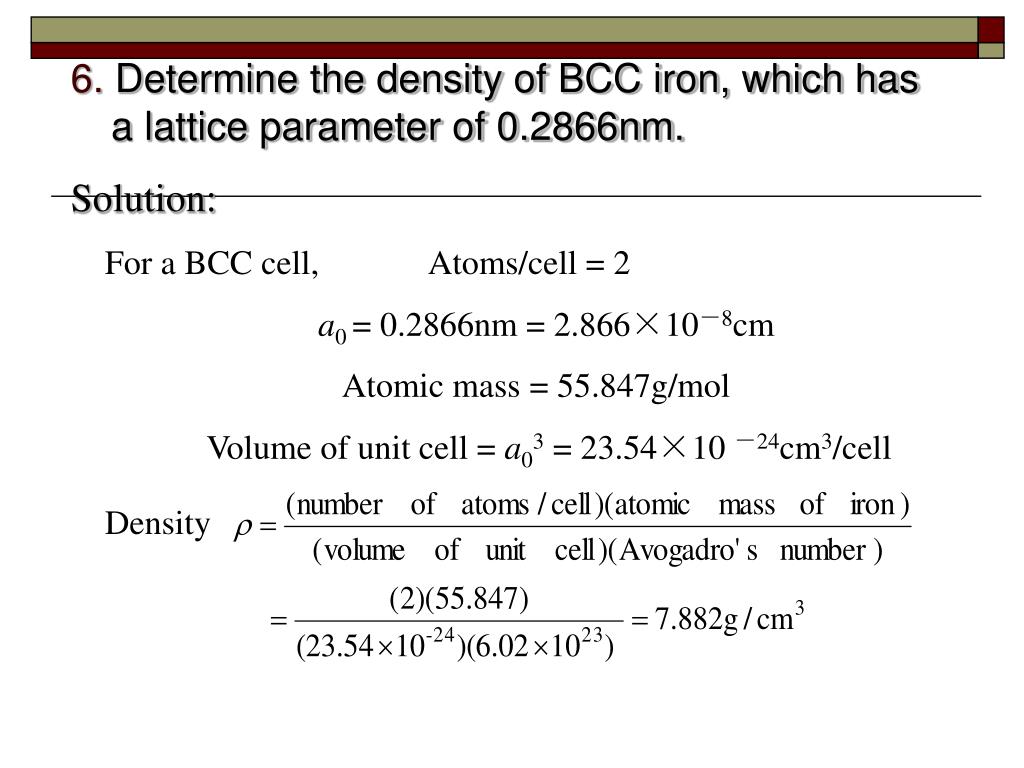
The volume of the primitive unit cell will thus be SIDE NOTE This will of course be equivalent to Now the area of a rhombus can be expressed using the length of its side and an interior angle. The volume of this primitive unit cell will thus be equal to the area of the rhombus that makes up its base and the height of the cell. More specifically, you can use the fact that Mind you, I will not derive this relationship here! Now, to get the volume of this primitive cell, you must use a known relationship that exists between the length of the cell and it height, usually given as #c#. Here #r# represents the radius of an atom. If you take #a# to be the length of this primitive unit cell, you can say that you have This primitive unit cell will contain #2# atoms.

Projecting this primitive cell here will get you #3 xx "1 atom" + 2 xx 1/2color(white)(a)"atoms" + 12 xx 1/6color(white)(a)"atoms" = "6 atoms"#Īt this point, it would be easier to work with a primitive unit cell, which is equivalent to #1/3"rd"# of a unit cell. The total number of atoms that can fit in a HCP unit cell will thus be #1/6"th"# of an atom for every lattice point located in the corners of the unit cell.#1/2# of an atom for every lattice point located in the center of the two bases.#1# atom for every lattice point located in the center of the unit cell.Now, take a look at how the atoms are packed in the unit cell. twelve lattice points in the corners of the unit cell.two lattice points in the centers of the bases.three lattice points in the center of the cell.So, start by calculating how many atoms you get in a hexagonal closed-packed (HCP) unit cell.Ī HCP unit cell is a hexegonal prism that has a total of #17# lattice points eff." = "volume occupied by atoms"/"total volume of the unit cell"color(white)(a/a)|)))# #color(blue)(|bar(ul(color(white)(a/a)"pack. In order to calculate packing efficiency, you basically need to know three things Of sphere in hcp = 12 × 1/6 + 1/2 × 2 + 3 = 2+1+3 = 6∴ Volume of spheres = 6 × 4/3πr 3∴ Percentage of space occupied by sphere = 6 × 4/3 πr 3 / 6 × √3/4 × 4r 2 × 4√2/3 r × 100 = 74% ”Calculation Involving Unit Cell DimensionsFrom the unit cell dimensions, it is possible to calculate the volume of the unit cell.Packing efficiency is all about how much space is being occupied by the atoms present in a unit cell. Assuming that B atoms exactly fitting into octahedral voids in the HCP formedby ASolution:Total volume of A atom = 6 × 4 / 3 πr A 3Total volume of B atoms = 4 × 4/3 πr A 3 4 × 4/3 π(0.414r A) 3Since r B/r A as B is in octahedral void of AVolume of HCP = 24√2r A 3Packing fraction = 6 × 4/3 πr A 3 + 4 × 4/3 π (0.414r A) 3 / 24√2r A 3 = 0.7756Void fraction = 1-0.7756 = 0.2244 Question 3:Show by simple calculation that the percentage of space occupied by spheres in hexagonal cubic packing (hcp) is 74%. Of atoms present in 200gm of the element.Solution:Number of atoms contributed in one unit cell = one atom from the eight corners + one atom from the two face diagonals = 1+1 = 2 atomsMass of one unit cell = volume × its density= 24 × 10 –24 cm 3 × 7.2 gm cm 3= 172.8 × 10 –24 gm∴ 172.8 10 –24 gm is the mass of one – unit cell i.e., 2 atoms∴ 200 gm is the mass = 2 × 200 / 172.8 × 10 –24 atoms = 2.3148 × 10 24 atoms Question.Ģ:Calculate the void fraction for the structure formed by A and B atoms such that A form hexagonal closed packed structure and B occupies 2/3 of octahedral voids. If the volume of this unit cell is 24 x 10 -24 cm 3 and density of the element is 7.20gm/cm 3, calculate no. But from the right angled triangle ACDAC = √AD 2 + DC 2 = √a 2 + a 2= √2a4r = √2aor a = 4/√2 r∴ volume of cube = (2/√2 r) 3Watch this Video for more referenceThus, it is concluded that ccp and hcp structures have maximum packing efficiency.Solved ExamplesQuestion 1:An element crystallizes into a structure which may be described by a cubic type of unit cell having one atom in each corner of the cube and two atoms on one of its face diagonals. Of spheres in bcc = 2∴ volume of 2 spheres = 2 × 4/3πr 3Face-Centred Cubic (hcp and ccp Structures)Let ‘r’ be the radius of sphere and ‘a’ be the edge length of the cube.


 0 kommentar(er)
0 kommentar(er)
